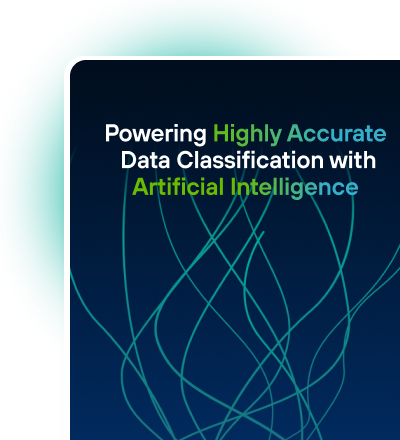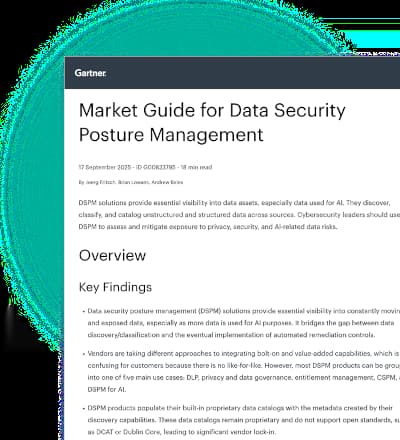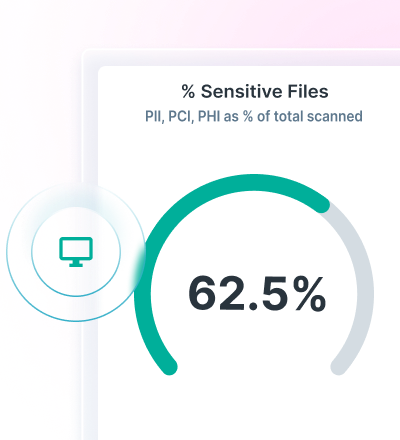Kurumsal verileri yıldırım hızında bulun ve kataloglayın.
Forcepoint Data Classification, son derece doğru Data Classification sağlamak için AI Mesh kullanır. Ağ bağlantılı yapay zeka mimarisi, verimliliği artırmak ve yanlış pozitifleri azaltmak için Küçük Dil Modeli ve gelişmiş yapay zeka bileşenlerine dayanır.


Gartner®: Market Guide for Data Security Posture Management
In their first analysis of the new DSPM security category, Gartner® identifies the five main use cases, breaks down DSPM features and explores the requirements for securing GenAI.
Neden Forcepoint Data Classification?
Verileri birden fazla kaynaktan sınıflandırın ve AI Mesh kullanarak verimliliğini ve doğruluğunu sürekli artırın, kuruluşlara değerli zaman ve kaynaklardan tasarruf sağlayın.
Sektördeki en geniş veri türü yelpazesini kapsamak, düzenleyici uyumluluğu kolaylaştırır ve kuruluşların verileri için daha iyi koruma sağlar.
Data Classification için gereksinimleri ve kriterleri seçmek ve DLP politikalarını kapsamlı yeniden eğitimlere gerek kalmadan kolayca uygulamak için Kurumsal Veri Kaybı Önleme (DLP) ile entegre edin.
AI Mesh verileri hızla ve doğru bir şekilde sınıflandırarak, süreçleri kolaylaştırarak ve manuel çalışmaları azaltarak ekiplerin daha yüksek değerli görevlere veya daha önemli olaylara odaklanmasını sağlar.
Hazır önemli düzenlemeler ve sektördeki en geniş veri türü kapsamı ile maliyetli uyumsuzluk cezalarından kaçının.

İhtiyacınız Olan Her Yerde Veri Güvenliği Forcepoint ile verilerinizi her yerde güvence altına alın.
Veri güvenliği çözümlerimizle ihlalleri önleyin, uyumluluğu basitleştirin, politika yönetimini birleştirin ve risklere gerçek zamanlı olarak uyum sağlayın.
Forcepoint DLP: Hassas bilgileri güvence altına alın ve DLP Software-as-a-Service (SaaS) ile uyumluluğu sağlayın.
Data Security Posture Management (DSPM): Veri keşfi, sınıflandırması ve yönetimini otomatikleştirerek verileriniz üzerinde kurumsal kontrol ve görünürlük elde edin.
Risk-Adaptive Protection: Politikalarınızı kullanıcı davranışlarına göre otomatik olarak ayarlayarak ortaya çıkan risklere gerçek zamanlı olarak uyum sağlayın.
Sıkça Sorulan Sorular
Data Classification nedir?
Data Classification, verileri önceden tanımlanmış kategorilerde etiketleme ve organize etme uygulamasıdır, böylece yetkili kullanıcılar için güvenli erişim sağlanırken verilerin bulunması ve geri alınması kolaylaştırılır.
Data Classification kuruluşlar için neden önemlidir?
Data Classification uygulamaları, güçlü bir güvenlik yaklaşımını sürdürmek için gereklidir. Güvenlik ekiplerinin hassas bilgileri nerede bulabileceklerini bilmelerini sağlayarak ve bu bilgilere kimlerin erişmesine izin verildiğine dair kurallar koyarak, veri ihlallerini önleyebilir veya kontrol altına alabilir ve yetkisiz kullanıcıları kullanmamaları gereken kaynaklardan uzak tutabilirsiniz.
Data Classification türleri nelerdir?
İçerik tabanlı sınıflandırma: Bu, dosyaları inceleme ve içlerindeki hassas bilgileri arama uygulamasıdır. Bu, görünüşte zararsız görünen dosya türlerinde saklanan kamuya açık olmayan bilgilerle ilgili bir sorununuz olduğunda yararlı olabilir.
Bağlam tabanlı sınıflandırma: Bu yaklaşım, dosya içeriğini doğrudan incelemek yerine, dosyalarla ilişkili meta verileri inceleyerek içindeki verilerin hassas olduğuna dair ipuçlarını bulur. Bu, bir dosyanın nerede depolandığını, hangi kullanıcının oluşturduğunu veya dosyanın hangi uygulama için oluşturulduğunu belirlemeyi içerebilir. Bu yaklaşım, kullanıcı tabanınız iyi eğitimli olduğunda ve hassas verileriniz üzerinde halihazırda bir dereceye kadar kontrol sahibi olduğunuzda etkilidir.
Kullanıcı tabanlı sınıflandırma: Bu, dosyaları tarama ve kategorilere ayırma yükünü kullanıcıların üzerine bırakır. Bu yaklaşım, en iyi durumda yanlış pozitifleri önemli ölçüde azaltabilse de, yalnızca yüksek düzeyde eğitimli bir kullanıcı tabanına sahip olmayı değil, aynı zamanda verileri manuel olarak sınıflandırmak için zamana da sahip olmayı gerektiriyor. Bu, genellikle yalnızca daha yalın kuruluşlar veya daha küçük veri kümeleri için uygun olduğu anlamına gelir.
Data Classification'ı uygulamak için en iyi uygulamalar nelerdir?
Tanımlama: Bulut depoları ve fiziksel sabit diskler dahil olmak üzere hassas verilerinizin nerede bulunduğunu bulun ve şifreleme, fiziksel erişim kontrolleri vb. ile güvence altına almak için gerekli olan derhal adımları atın.
Organizasyon: Verileri kategoriler halinde organize etmek için kullanacağınız süreci belirleyin.
Eğitim: Çalışanları, verileri etiketlemede ve kategorilerine göre uygun yere yerleştirmede rol oynamaları için güçlendirin. Süreçte rol oynayan kişi sayısı arttıkça, insan hatalarının çalışmalarınızı tehlikeye atmamasını sağlamak için eğitimleriniz o kadar titiz olmalıdır.
Uyumluluk: Operasyonlarınız için geçerli veri güvenliği ve veri gizliliği düzenlemelerini ve uyumsuzluklar için uygulanan cezaları anlayın.
Çözümler: Kuruluşunuza en uygun Data Classification çözümünü bulun. Çoğu durumda, çeşitli tedarikçilerden gelen farklı çözümleri bir araya getirmek yerine, veri keşfi, sınıflandırması ve önceliklendirmede yardımcı olabilen kapsamlı bir veri güvenliği platformundan yararlanmak en iyi seçenektir.
Data Classification, düzenlemelere uyumluluk konusunda yardımcı olabilir mi?
Evet, Forcepoint Data Classification 80'den fazla bölgede uyumluluğu kolaylaştırmaya yardımcı olabilir. Hazır önemli düzenlemeler ve sektördeki en geniş veri türü kapsamı ile uyumsuzluk nedeniyle uygulanan yüksek maliyetli cezalardan kaçınmanıza yardımcı olur.
Forcepoint Data Classification ne kadar doğru?
Forcepoint Data Classification, yapay zeka destekli hassasiyet ve verimlilikten yararlanır. AI Mesh teknolojisini kullanarak, verileri birden fazla kaynaktan sınıflandırır ve doğruluğunu ve verimliliğini sürekli artırarak kuruluşlara değerli zaman ve kaynaklardan tasarruf sağlar.
AI Mesh nedir ve nasıl kullanılır?
Forcepoint Data Classification, son derece doğru Data Classification sağlamak için AI Mesh kullanır. Ağ bağlantılı yapay zeka mimarisi, verimliliği artırmak ve yanlış pozitifleri azaltmak için Küçük Dil Modeli ve gelişmiş yapay zeka bileşenlerine dayanır.











